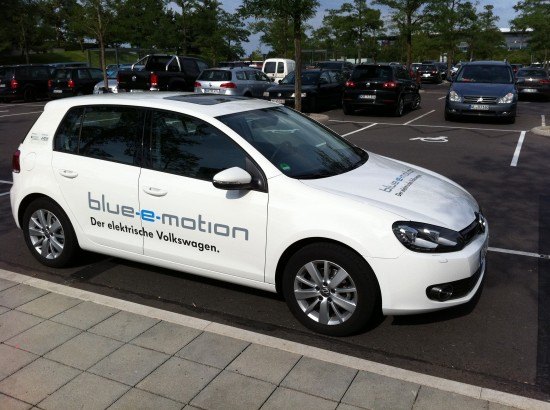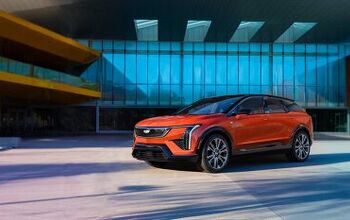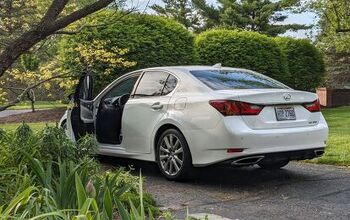Pre-Production Review: Volkswagen Golf Blue-e-motion
As I noted in an earlier piece on the macro-level issues with EVs, it’s dangerously misleading to assume that electric cars can simply replace internal combustion-engine vehicles without a basic re-think of nearly every way in which we relate to our cars. That’s true in terms of consumer-end issues like refueling grid impacts and “range anxiety” but it’s also true in terms of manufacturer-end issues like development and differentiation. It’s even true for the auto media.
One of the giant re-thinks spawned by EV development is in how manufacturers make their vehicles reflect their brand values and stand out in the marketplace, as the electric motor in (say) a Ferrari EV wouldn’t be as fundamentally different as an electric motor in (say) a Kia. This, in turn, makes reviewing EVs extremely difficult, as they all display similar power attributes, weight challenges, single-speed transmissions and battery ranges. So when you are asked to drive a pre-production EV from a major manufacturer, the major question in the mind of the conscientious reporter is the same as the question that drove the vehicle’s development: how is this vehicle different than any other EV? In the case of the Golf blue-e-motion, the answer to that question reflects the challenges of developing a major-market electric vehicle.
But before we dive into what makes the Golf blue-e-motion unique, we have some background to get through. Having spent the last decade joining its German brethren in poo-poo-ing EVs and hybrids, Volkswagen has finally decided that it makes sense to develop a pure EV for eventual mass-market sales. And rather than buying into a company like Tesla, as VW’s arch-rival Toyota did, VW set up its own battery research team around Tesla founder and former CEO Martin Eberhard. When I toured VW’s Palo Alto Electronics Research Lab last year, Eberhard’s contribution was already visible in the form of renderings of battery arrays for this Golf blue-e-motion and the Audi e-tron electric sportscars. Just like the battery packs that Eberhard developed at Tesla, the VW systems eschew the expensive prismatic cells used by Nissan’s Leaf and Chevy’s Volt in favor of 18650 cells, the cheapest, most-produced format for lithium-ion cells. Using these cells, argues VW, will make its packs more energy-dense, safer and cheaper than the competition. And to think, they got so much of the 18650 array know-how without even buying into the strategic nightmare that is Tesla!
In the Golf blue-e-motion, 180 of these AA battery-sized 18650 cells are packed into modules, 30 of which are assembled into a pack that occupies the bottom and rear of the car, including the cargo area underfloor, under the rear seats, and in the central tunnel of the Golf’s underbody. With active air/water thermal management, the battery pack weighs nearly 700 lbs, but thanks to a lightweight electric motor and other weight-saving measures, it ends up weighing about 3,400 lbs, just 50 lbs more than Nissan’s Leaf (which does not have active thermal management) and 450 lbs more than a Golf TDI with DSG. And because that weight is all concentrated low and to the center of the car, it carries its weight through the corners with the grace of a much lighter car (as do most EVs).
Volkswagen estimates that the 26.5 kWh battery array can power the Golf to a maximum range of 93 miles, for functionally similar usability as a Nissan Leaf (provided these numbers hold up in testing, we weren’t allowed to test range on our drive).
But, also like most EVs, the Golf blue-e-motion only feels remotely sprightly from a stop, when its zero-RPM max torque twists it from a stop with adequate brio (VW estimates 11.8 seconds for 0-60). Though it offers a lower peak output of 85 kW than the Chevy Volt (with 111 kW) and a slower 06-60 time (by nearly three seconds), it feels remarkably similar in terms of seat-of-the-pants performance in the moderately-trafficked street conditions I saw in our test drive in Wolfsburg. Fun for the first few seconds followed by some building frustration at the single-geared drivetrain (which the Volt mitigates slightly better) is the major impression. All told, the Volt is quicker and possibly a bit more fun to toss in the corners, but the distinction is basically academic as neither car is performance oriented in any meaningful sense.
One strange feature that took some getting used to: the lack of “creep” when you take your foot off the brake. Whereas the Volt eases forward when you let off the brake, just like an automatic-equipped ICE car, the Golf blue-emotion just sits there like it’s in neutral (or using a stop-start-equipped ICE) until you give the throttle a hesitant stab. It doesn’t actively interfere with driving, but with 100 percent of your torque available at 0 RPM, the lack of ease-in might make some American drivers uneasy. Use a steady right foot and you’ll have no problems, and it seems like the kind of issue that one would stop noticing after even a few hours with the car.
Thus far, the Golf’s lack of off-throttle creep is its most distinctive characteristic among EVs. And VW could have simply left the development there, fighting the Leaf on a relatively level field (100 mile range with adequate performance and space) while adding a Volt-style thermal management system (only without the complex ICE component). If the price point were right, that would be a relatively marketable car. But instead, VW felt it had to bring something to the table in hopes of justifying its less-than-entirely-groundbreaking project. The holy grail of EV development is a multi-speed transmission (which nobody has been able to build tough enough to reliably handle an EVs torque output), but that would have been far too complex for VW to include on a production bound vehicle (more on that in a bit). So instead of giving its EV a transmission, VW did the next best thing: allowing drivers to “shift” the regenerative braking system. Row, row, row your… brakes?
In addition to three “driving profiles” which vary power mapping and AC power use for improved range or power, VW has included no fewer than four regenerative braking modes. Like the Volt, the shift column has both “drive” and “low” settings, the latter of which provides the most extreme engine braking for heavy traffic or slow hill descents. In this mode the off-throttle regeneration is almost neck-snappingly extreme, slowing the car strongly and progressively as soon as you get off the “gas.” In “drive” the Golf blue-e-motion offers three separate modes which are selected not with the shifter, but with DSG-style paddle shifters mounted behind the steering wheel. Two modes offer varying degrees of regeneration, ranging from a gentle slowing to a stronger regeneration but both are less extreme than the “low” setting. Accompanying these two modes is the “sail” mode which allows the Golf to coast in light traffic with no off-throttle regeneration at all.
This is an innovation I’ve been waiting for since I first drove an EV… although in my mind I imagined a separate lever for infinitely-variable regeneration. In practice, however, it does take a little getting used to. Flipping between coast mode for empty roads and light throttle openings and progressively stronger regen modes as traffic built up was a genuine challenge at first. And even as comfort with the “anti-shifting” builds you do get the sneaking suspicion that you’re working awfully hard for relatively small range savings. But then I realized just how similar this Golf was to the other EVs on the market, and that this variable-regen system is one of the more meaningful differentiations available to pure electric driving (and one that Tesla should be listening to customers about). And then something else occurred to me: it’s also fun to be driving an EV that actually engages the driver. Sure, it’s more like the video-game trance you get from a hybrid than the man-machine melding you’d get piloting a manual-transmission sports car on a winding road, but it’s engagement nonetheless. In the era of electric vehicles you take what you can get.
Speaking of taking what you can get, you won’t ever be able to buy this specific car, which will spend the next two years testing in various car-sharing and corporate fleets around Europe. VW’s first EV will be an electric version of the Up! city car which goes on sale in Europe in 2013, but likely won’t be headed to the US. This Golf blue-e-motion will continue to be tested and refined until 2014, when a production version will debut, sporting the next-gen Golf VII looks and underpinnings. So, by mid-to-late 2014, this seemingly competent and ever-so-slightly innovative Golf blue-e-motion could well become the first pure electric Volkswagen sold in the US. Which raises an interesting question: will its incremental innovations still be news by then? With new chemistries in its 18650 cells, the Golf blue-e-motion could well move the game on from the Leaf’s opening position, but in its current form it seems more of an evolutionary half-step. And as far as Volkswagen or I know, EVs could be rocking multi-speed transmissions by the time this comes to market in 2014.
Volkswagen flew the author to Wolfsburg, Germany to drive the vehicle for this review. Over the course of the trip, the author was treated to multiple meals, free lodging, a factory tour, an Autostadt tour and a women’s World Cup soccer game.
More by Edward Niedermeyer
Latest Car Reviews
Read moreLatest Product Reviews
Read moreRecent Comments
- FreedMike Sounds like Apple wants to recoup some of the bucks it spent on the car project.
- EBFlex Insatiable demand for EVs yet this happens. And a lot more layoffs at Tesla.
- SCE to AUX Maybe some Apple tech would be helpful, but please no self-driving stuff.
- SCE to AUX It's over, and over the last decade or so Henrik Fisker has left two eras of foolish customers driving paper weights.
- Kwik_Shift_Pro4X Always a good sign. 🤕 I would like to see their pitch on Shark's Tank/Dragon's Den






































Comments
Join the conversation
"although in my mind I imagined a separate lever for infinitely-variable regeneration." Clutch pedal assembly hooked up to a potentiometer: boomderyago.
Question (not related to VW), why doesn't the volt have alteast a two speed transmission b/t the engine and the generator?